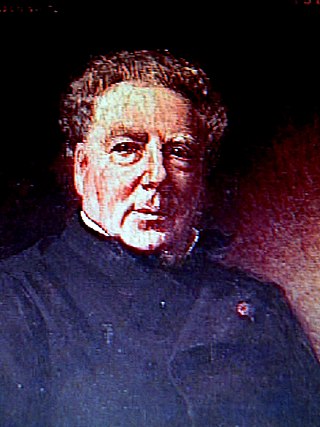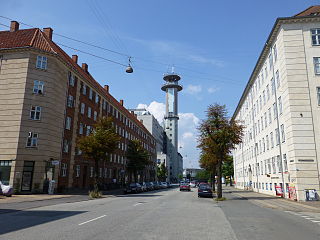
City Hall Square is a public square in the centre of Copenhagen, Denmark, located in front of the Copenhagen City Hall. Its large size, central location, and affiliation with the city hall makes it a popular venue for a variety of events, celebrations and demonstrations. It is often used as a central point for measuring distances from Copenhagen.

Auguste Nicolas Caïn was a French sculptor in the Animaliers school, known for his portrayals of wild and domesticated animals.

Jarmer's Tower is an old ruined tower in Copenhagen, Denmark. It was once part of the Copenhagen moat. Jarmers Tower represents the remains of the original eleven towers which were once joined together as a part of the city’s medieval fortification.

Østre Anlæg is a public park in Copenhagen. Once it was a part of the old city fortifications. The park was designed by landscape architect H.A. Flindt who also designed Ørstedsparken and Copenhagen Botanical Garden on the old fortification. The park lies between The National Art Museum at the southern end, and Oslo Plads and Østerport Station at the northern end. There are three lakes in this park, they used to be part of the moat system.

Sankt Annæ Plads is a public square which marks the border between the Nyhavn area and Frederiksstaden neighborhoods of central Copenhagen, Denmark. It is a long narrow rectangle which extends inland from the waterfront, at a point just north of the Royal Danish Playhouse at the base of the Kvæsthus Pier, now known as Ofelia Plads, until it meets Bredgade. A major renovation of the square was completed in 2016.The Garrison Church is located on the south side of the square. Amaliegade, one of the two axes on which Frederiksstaden is centered, extends from the square.

Sankt Hans Torv is a public square in the heart of the Nørrebro district of Copenhagen, Denmark. It is dominated by a large granite sculpture by Jørgen Haugen Sørensen and is known for its thriving café scene. St. John's Church, the largest and oldest church in Nørrebro, is situated just east of the square.

Vester Voldgade is a street in Copenhagen, Denmark which runs from Jarmers Plads to the waterfront between Frederiksholms Kanal and Langebro, passing the City Hall Square on the way.

Nørre Voldgade is a street in central Copenhagen, Denmark. It runs north-east from Jarmers Plads for approximately 600 metres to Gothersgade where it turns into Øster Voldgade. The succession of Nørre Voldgade, Øster Voldgade and Vester Voldgade together forms a traffic artery which arches around the Zealand side of the central and oldest part of Copenhagen. Nørreport Station, Denmark's busiest railway station, is located in the street.

Sønder Boulevard is a boulevard in the Vesterbro district of Copenhagen, Denmark, whose broad central reserve has been turned into a linear park with various facilities for sports and other activities. It runs from Halmtorvet next to Copenhagen Central Station in the north east to the Carlsberg district in the southwest.

Grønningen is a street in central Copenhagen, Denmark, connecting Bredgade and the intersecting street Esplanaden to Oslo Plads in front of Østerport Station along the southwestern margin of the fortification Kastellet. It lends its name to the artists' cooperative Grønningen which was originally based in the street.

Gammel Kongevej is the principal shopping street of Frederiksberg in Copenhagen, Denmark. Running roughly parallel to Frederiksberg Allé and Vesterbrogade, it extends from Vesterport station at the southern end of The Lakes and continues for some 1.8 km west to Frederiksberg City Hall Square where it continues as Smallegade. In the opposite end, Jernbanegade connects it to Copenhagen City Hall Square.

H. C. Andersens Boulevard is the most densely trafficked artery in central Copenhagen, Denmark. The 1.3 km long six-lane street passes City Hall Square on its way from Jarmers Plads, a junction just north of Vesterport station, to Lange Bridge which connects it to Amager Boulevard on Amager. From Jarmers Plads traffic continues along Gyldenløvesgade which on the far side of The Lakes splits into Aaboulevard and Rosenørns Allé. At the City Hall Square the boulevard meets Vesterbrogade, another very busy and importaint street. Major landmarks along the street include Copenhagen City Hall, Copenhagen Central Fire Station and the Ny Carlsberg Glyptotek.

Dantes Plads is a public square located in front of the Ny Carlsberg Glyptotek where it connects H. C. Andersens Boulevard to Vester Voldgade in central Copenhagen, Denmark.

Axeltorv is a public square in central Copenhagen, Denmark, located across the street from Tivoli Gardens' main entrance on Vesterbrogade.

Vester Farimagsgade, Nørre Farimagsgade and Øster Farimagsgade is a succession of streets which together connect the south-western Vesterbro to the northern Østerbro along the periphery of the city centre in Copenhagen, Denmark. A continuation of Reventlowsgade, Vester Farimagsgade extends from Vesterbrogade at Vesterport Station and initially runs along the sunken railway tracks on the left before soon reaching H. C. Andersens Boulevard. It then turns into Nørre Farimagsgade and continues behind Ørsted Park to Gothersgade where it becomes Øster Farimagsgade and proceeds along another green space, the Copenhagen Botanical Garden, passes Sølvtorvet and the neighbourhood of terraced houses known as Kartoffelrækkerne before terminating at Lille Triangel where Østerbrogade begins.

Borups Allé is a major artery in the northwestern part of inner Copenhagen, Denmark. The 3.2 km long street runs from Jagtvej at Nuuks Plads in the southeast to Bellahøj in the northwest. Just before Hulgårdsvej, part of Ring 2, Borups Allé is joined by Bispeengbuen, an elevated road section that connects it to Åboulevard-Ågade and H. C. Andersens Boulevard in the city centre. The rest of Borups Allé is the first leg of the National Road 16, part of the Danish national road network. It continues as a six-lane road to Frederikssundsvej where it becomes Hareskovvej and later the Hillerød Motorway at Utterslev Mose.

Nikolaj Plads is a public square located at the foot of the former St Nicolas' Church, just off Strøget, in the Old Town of Copenhagen, Denmark. Most of the buildings that line the square date from the rebuilding of the surrounding neighbourhood in the years after the Copenhagen Fire of 1795. The square is a quiet alternative to the much busier squares Amagertorv and Højbro Plads. The former church houses an exhibition space and a restaurant with outdoor service and a small playground is also located at the site.

Gyldenløvesgade is a street in central Copenhagen, Denmark. It runs from Jarmers Plads in the south east to a Y junction at the western side of The Lakes, linking H. C. Andersens Boulevard with Aaboulevarden and Rosenørns Allé. The last section of the street runs on an embankment which separates Peblinge Lake to the north from Sankt Jørgen's Lake to the south. The Lake Pavilion overlooks Peblinge Lake on the north side of the street.

Christians Brygge is a waterfront and street in central Copenhagen, Denmark. It runs from the mouth of Slotsholmen Canal in the north to Langebro Bridge in the south where it turns into Kalvebod Brygge. Its northern end, which is located on the small isle of Slotsholmen, is connected to Niels Juels Gade and then Holmens Kanal by Christian IV's Bridge. Christians Brygge The road section is part of Ring 2. The name refers to Christian IV, king of Denmark during the first half of the 17th century, who constructed several buildings at the site, including the Arsenal and Christian IV's Brewhouse as well as nearby Børsen. Other landmarks along the quay include the Royal Danish Library and the mixed-use building BLOX, home to the Danish Architecture Centre.

Christmas Møllers Plads is a major junction located in front of the embankment to Christianshavn on northern Amager in Copenhagen, Denmark. It links Torvegade, the main thoroughfare of Christianshavn, with Vermlandsgade, Amagerbrogade, Amagerfælledvej and Ved Stadsgraven-Amager Boulevard. Its name commemorates the Conservative politician Christmas Møller who had been active in the resistance movement during World War II and later served as Minister of Foreign Affairs.

























